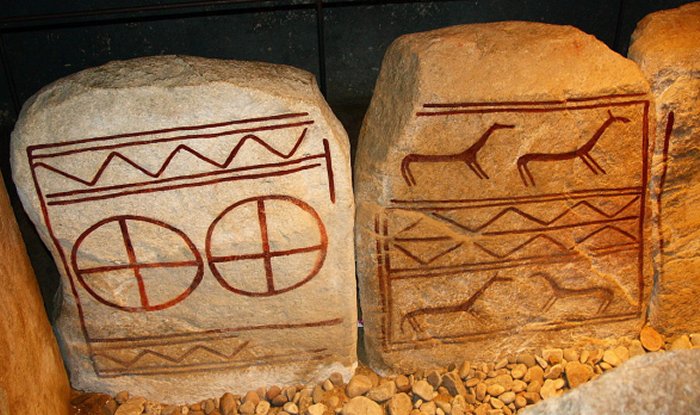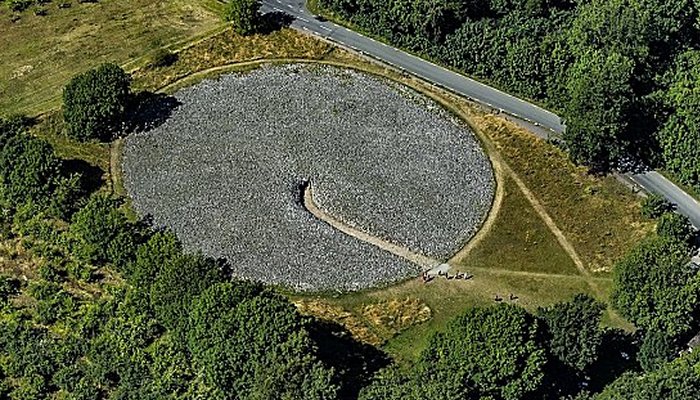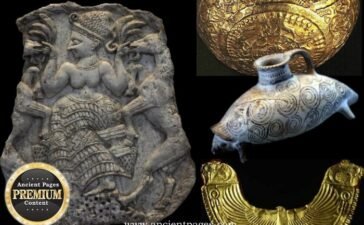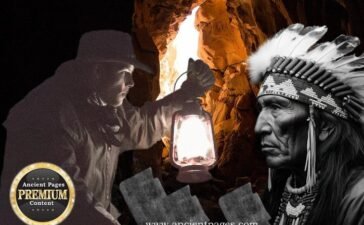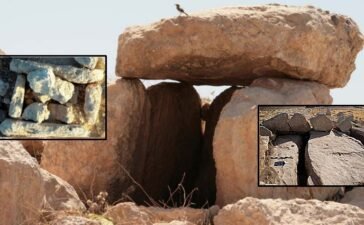A. Sutherland – AncientPages.com – The large stone cairn known as Bredarör (sometimes called the King’s Grave), located outside Kivik in Scania (Skåne), served as a quarry for local residents for many years.
One of ten slabs of stone shows a horse drawn chariot with two four-spoked wheels. Image credit: Sven Rosborn – CC BY-SA 3.0
On June 14, 1748, two peasants gathering stones from the site unexpectedly uncovered a peculiar burial chamber.
Hoping to find treasures, the two men dug all night but found nothing. Rumors among the locals spread, and many believed that they had discovered a treasure. Soon, the two were imprisoned, suspected of stealing the grave’s contents.
Kivik’s Bredarör, constructed approximately 3,000 years ago, measures 75 meters in diameter and is regarded as one of northern Europe’s largest Bronze Age graves.
Its considerable size earned it the name “King’s Grave.”
Archaeological studies have revealed that Kiviksgraven has functioned as a burial ground for at least 600 years. This finding underscores the site’s historical significance and its long-standing role in ancient burial practices.
Drawings of the Kivik Grave from the 18th and 19th centuries. Source; Image credit: Christopher Sommerfeld – CC0 1.0
The King’s Grave’s widespread recognition is attributed not only to its impressive dimensions but also to other factors. Notably, this fame was established even before the later discovery of two burials within the site.
The limited number of artifacts discovered—such as double buttons, fragments of a round cauldron, nails, and a long piece of metal—left archaeologists and ordinary people puzzled. The absence of additional items only added to the intrigue and suspicions surrounding the site.
In 1931, the grave was thoroughly excavated for the first time. Various items were discovered during this excavation, including pottery, flint, animal bones, burnt bones, and human teeth.
The stones of the grave facing the grave of Kivik. Image credit: Uwe Glaubach – CC BY 3.0
The mound contained two cists, probably, constructed simultaneously. At the southern end of the left cist, raised slabs of stone measuring 1.2 meters (3.9 feet) in length and 0.65 meters (2.1 feet) in width were found.
Analysis of bone fragments showed that they belonged to multiple individuals, at least four or five. Among them, one individual died between the ages of 25 and 35, while the others were young individuals, all buried at the Kivik site.
This raises questions about their identities and connection to this location, which is believed to have been a significant trading hub as early as the Bronze Age.
Researchers are exploring whether Kivik’s Grave has any links to the copper and amber transactions that occurred there.
Stones within the cairn of Kivik. Image credit: Schorle – CC BY-SA 3.0
Expressive Carvings In Bronze Age, Bredarör
Bredarör, also known as Kivik’s Grave, is a notable circular structure distinguished by its unique construction and size. Unlike most European burials from the Bronze Age, Bredarör stands out due to these distinctive characteristics.
Under the mound with a diameter of 75 m, an elongated burial chamber measuring 4.4 × 0.9 m erected from stone slabs was found.
Inside the burial chamber, eight stones were found leaning like a coffin and covered with carvings depicting a sacrificial scene with musicians playing wind instruments, processions, chariots with harnesses, four-spoked wheels with an inscribed cross (symbol of the sun), cows, other four-legged animals, birds and fish, images of ships, and battle axes. No human remains or grave goods were found in the burial chamber (except for burnt bones, and human teeth), and it is believed that the grave was robbed, most likely shortly after it was built.
Aerial view of the Kivik grave. Image credit: L.G.foto – CC BY-SA 4.0
It’s undoubtedly some kind of an important message that prehistoric artists of the King’s Grave wanted to present for future generations. Did they only want to be remembered?
Understanding their message is challenging. What is the recommended order for interpreting the scenes recorded on the cists of the Bredarör burial chamber?
This Burial Place Is A Mystery
There are many questions: Who was buried under all the stones, and why did he, she, or they get such a huge burial ground? Who are all the figures on the rocks? How did the instruments they blew sound?
What kind of dance are they moving in? Is it a sacrificial procession, a summoning of the gods, or perhaps a burial ritual?
Written by – A. Sutherland – AncientPages.com Senior Staff Writer
Copyright © AncientPages.com All rights reserved. This material may not be published, broadcast, rewritten or redistributed in whole or part without the express written permission of AncientPages.com
Expand for references





